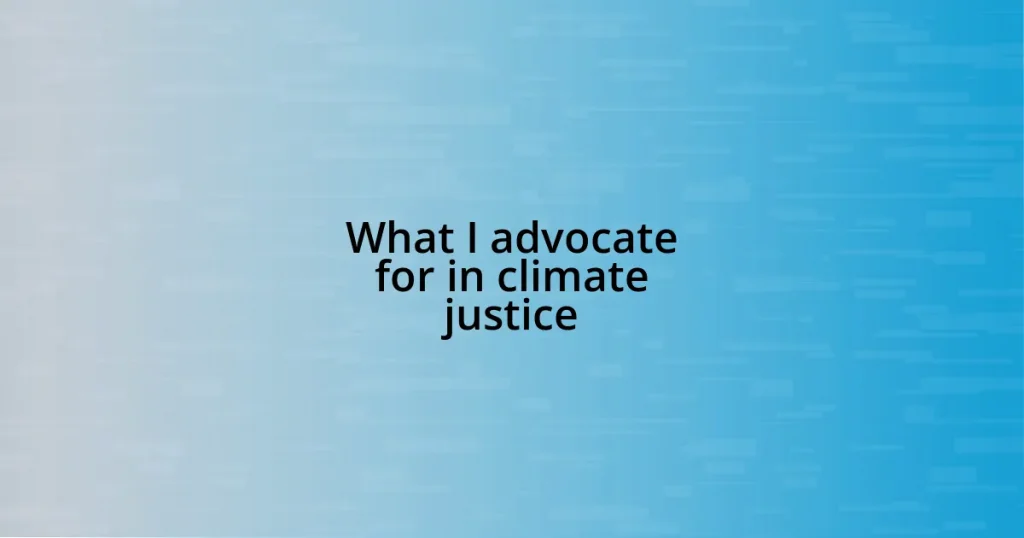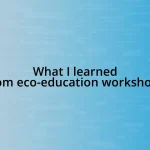Key takeaways:
- Climate justice highlights the inequitable impact of environmental degradation, disproportionately affecting marginalized communities.
- Inclusion in policy-making is essential; amplifying the voices of those most affected leads to more effective solutions.
- Advocacy for marginalized groups requires challenging systemic inequalities and ensuring access to resources for community-driven initiatives.
- Building community resilience through grassroots movements and local knowledge fosters effective climate strategies and collective action.
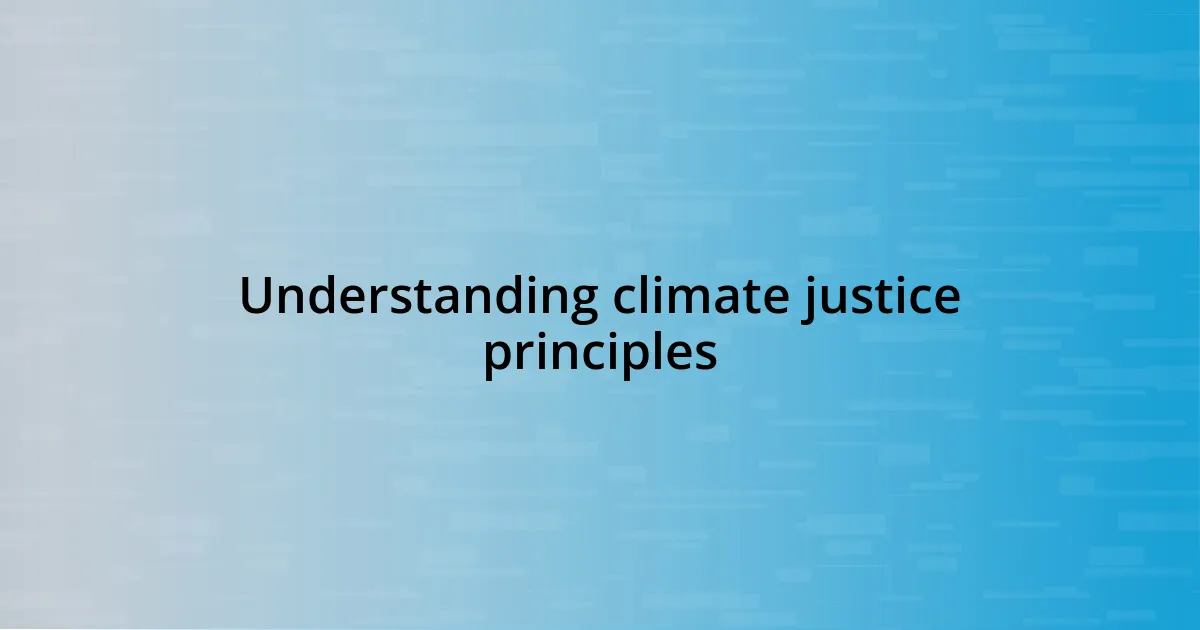
Understanding climate justice principles
Understanding climate justice principles is crucial for recognizing that those who contribute the least to environmental degradation often suffer the most from its consequences. I still remember the first time I met a young activist from a low-income community deeply affected by pollution. Hearing her story made me wonder: how is it fair that she bears the brunt of corporate negligence?
At the heart of climate justice lies the idea of equity. It compels us to ask who has the resources to adapt to climate change and who doesn’t. It’s disheartening to see entire communities that lack basic support systems swept aside while wealthier areas prepare for climate shifts. This disparity is something I’ve felt firsthand while volunteering in neighborhoods that are often overlooked.
Furthermore, climate justice emphasizes the need for inclusion in decision-making processes. It’s not just about policy changes; it’s about amplifying the voices of those most affected. I recall a community meeting where residents passionately demanded their opinions be heard. It struck me as a pivotal moment—one where true progress begins when everyone has a seat at the table.
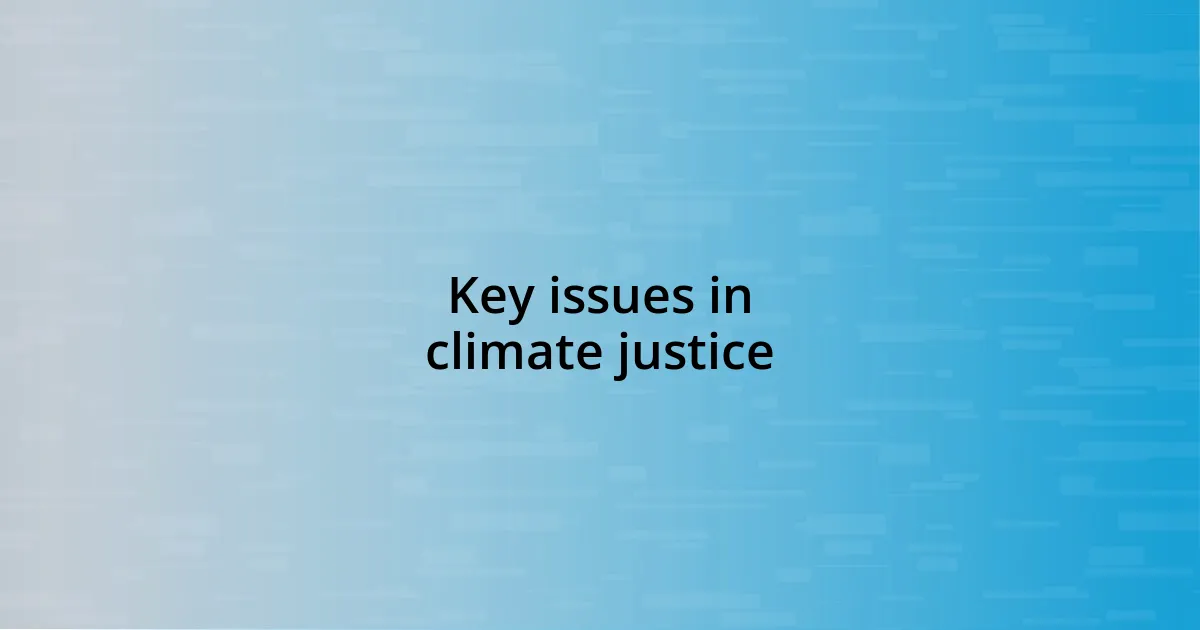
Key issues in climate justice
Climate justice encompasses several key issues that highlight the inequities in how climate change affects different communities. One vivid memory that stays with me is when I visited a coastal town facing severe flooding due to rising sea levels. The despair on the residents’ faces, especially among the elderly who had lived there their entire lives, left an indelible mark on my heart. Their stories illustrated the stark reality that while they were not the cause of climate change, they were disproportionately suffering its impact.
Here are some key issues central to climate justice:
- Disproportionate Impact on Marginalized Communities: Often, low-income and marginalized groups face the worst consequences of environmental degradation.
- Access to Resources: Wealthier communities can often shield themselves from climate effects, while poorer groups struggle to obtain necessary resources to adapt.
- Inclusion in Policy-Making: Genuine change requires listening to and involving those most affected by climate issues in the decision-making process.
- Economic Inequality: The financial burden of climate-related disasters falls more heavily on those with fewer resources, perpetuating cycles of poverty.
- Intergenerational Equity: The climate crisis affects not only present but future generations, raising ethical questions about the legacy we’re leaving behind.
These issues underline the urgent need for a just climate response that acknowledges historical injustices and seeks to rectify them.
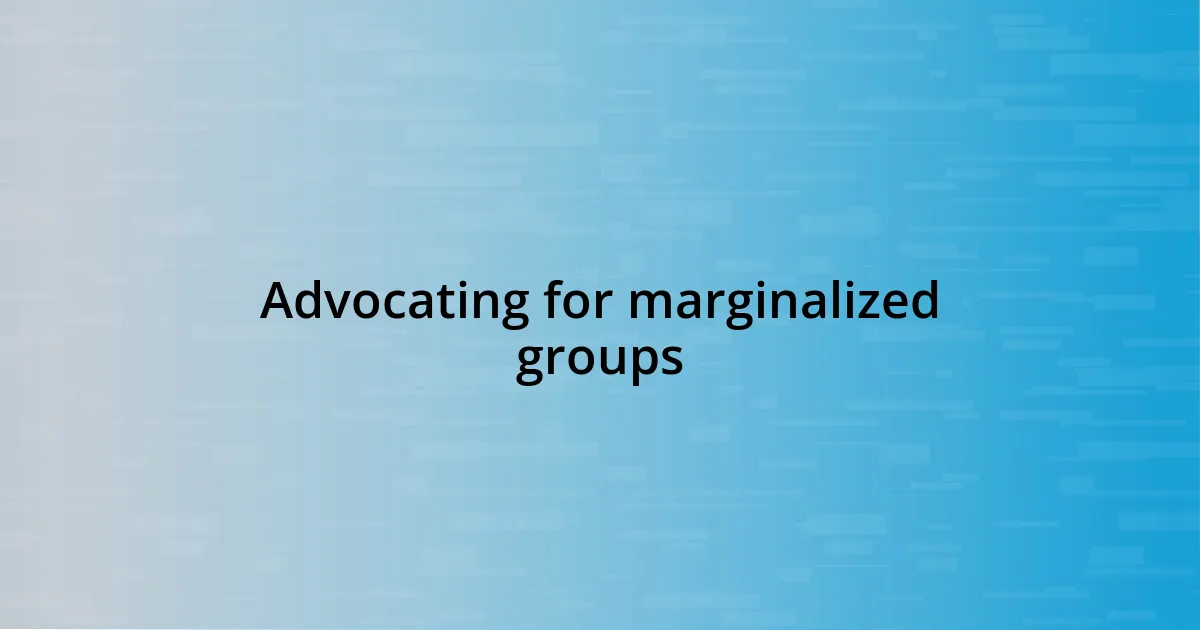
Advocating for marginalized groups
Advocating for marginalized groups is not just about sympathy; it’s about structured action and genuine acknowledgment of their struggles. I remember volunteering at a community garden in an underserved neighborhood. The residents, fueled by a sense of ownership, harnessed the power of local agriculture to create a sustainable food source. This experience highlighted something profound for me: marginalized groups often possess immense knowledge and resilience, yet they need resources and support to thrive.
Too often, their voices are silenced in discussions about climate policies. I recall attending a local council meeting where a woman from a marginalized community spoke up. Her insights about the immediate impacts of climate change on her home painted a vivid picture that statistics could never convey. This interaction made me realize that when we lift the voices of those most affected, we foster more effective and inclusive solutions.
Additionally, advocating for marginalized groups involves challenging systemic inequalities. I once met a group of climate activists from low-income backgrounds who tirelessly campaigned for better waste management in their area. Their determination was inspiring, yet it became painfully clear that they faced barriers that wealthier communities didn’t, like lack of access to funding and political influence. It’s this stark contrast that fuels my advocacy, driving me to push for equitable support mechanisms that empower marginalized groups.
| Key Factor | Marginalized Groups |
|---|---|
| Voices in Policy | Often excluded, yet have critical insights on local impacts. |
| Access to Resources | Struggle to secure funding and support, impacting their initiatives. |
| Resilience | Demonstrated through innovative community-led solutions. |
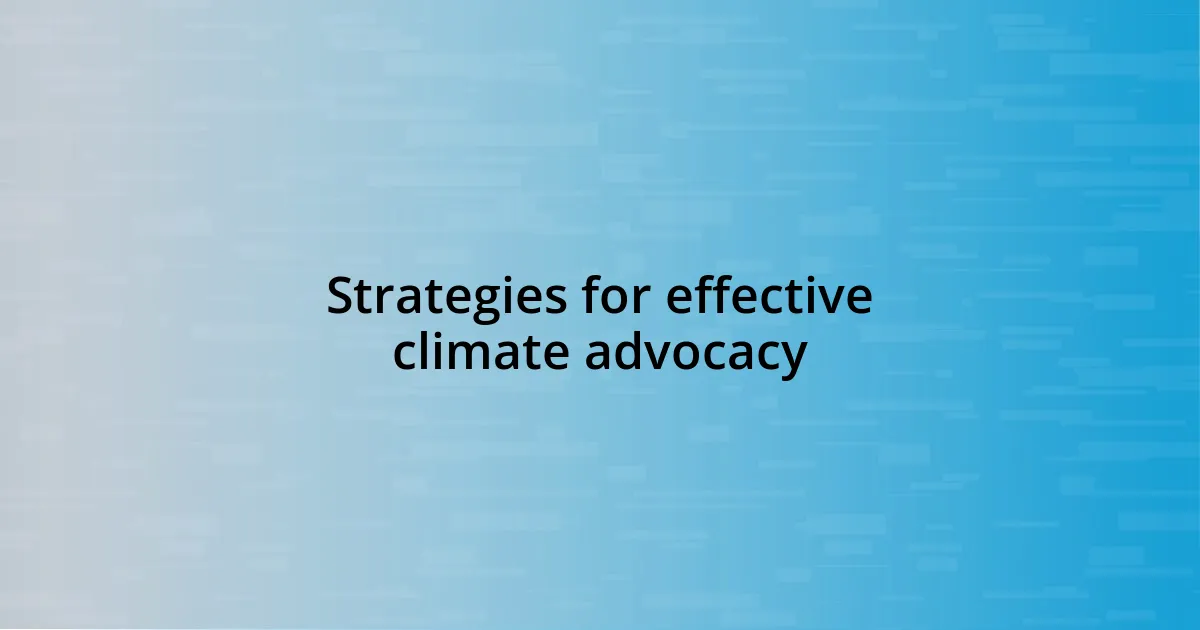
Strategies for effective climate advocacy
One effective strategy for climate advocacy is the power of storytelling. I vividly recall a community meeting where a resident shared her family’s experiences with increasingly severe storms. Her story not only captivated the audience but also underscored the real-life stakes of climate change. How often do we overlook the human side of data? By sharing personal narratives, we can foster empathy and urgency, transforming abstract statistics into compelling calls to action.
Engaging with local decision-makers is another crucial strategy that I’ve found to be impactful. I once accompanied a group of activists to speak with our city council about expanding green spaces in low-income neighborhoods. Armed with strong data and poignant stories, we made a case that resonated on both personal and political levels. It was inspiring to see the council members nodding as they connected our testimonies with their roles in these communities. This experience taught me that when we actively engage the people who shape our policies, we can create a ripple effect of positive change.
Moreover, building coalitions among diverse groups amplifies our advocacy efforts. I participated in a workshop that brought together activists from environmental justice, social equity, and local health organizations. Each group brought unique perspectives, but a common thread of shared values emerged. It reminded me that collective strength can tackle multifaceted challenges in a way that any single group might struggle to achieve alone. How might we harness our collective voices to challenge systemic injustices and drive policy reform? The answer lies in collaboration, which I believe is essential for addressing the urgent issues of climate justice effectively.
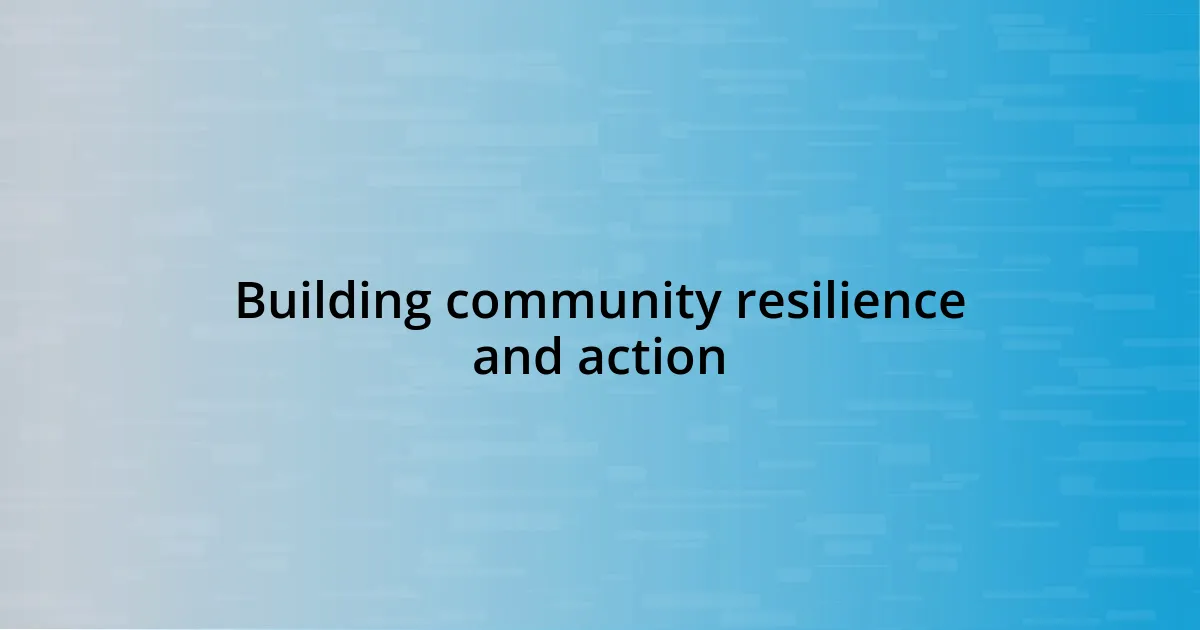
Building community resilience and action
Building community resilience starts with fostering meaningful connections among residents. I remember participating in a neighborhood cleanup organized by a local group. As we worked side by side, I saw how a common goal united us, transforming a simple task into a powerful bond that amplified our collective voice. It’s amazing how these shared experiences can cultivate a sense of responsibility and ownership, making community members more resilient to climate impacts.
I can’t stress enough how essential grassroots movements are for real change. There was a time when I joined a community workshop focused on disaster preparedness. The atmosphere buzzed with energy as people shared their experiences, fears, and ideas on how to protect their homes. In that space, I witnessed firsthand how knowledge and resource-sharing can empower individuals and transform entire neighborhoods. Isn’t it intriguing how grassroots efforts can often achieve what top-down initiatives overlook?
In my view, we must also prioritize local knowledge when developing climate strategies. One evening, I attended a forum where residents proposed innovative solutions based on their lived experiences. Their insights were eye-opening, revealing practical approaches that officials had never considered. I couldn’t help but think: if decision-makers truly listened, how much more effective could our climate action be? By embracing community expertise, we build not just resilience, but also dynamic, responsive action that addresses local challenges.











